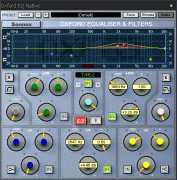ironmine
500+ Head-Fier
It's strange, but this new plugin DTS Neural UpMix sounds worse to me than another, quite old 2.0>5.1 upmixer called "Stereo to V.I. converter".
Here's how I do it now for Denon D2000. This is the full VST chain in Console:

The first VST is DDMF Metaplugin (www.ddmf.eu/product.php?id=3) oversampled x2 with Chris Walton's oversampler (see its description here http://sites.google.com/site/chrisrwalton/oversampler).

Oversampling is recommended to improve the quality of the sound processing. Inside the Meta Plugin I put the following VST effects:

http://www.stevethomson.ca/vi/
Here you can see the settings I prefer currently (I don't like the rear channels to be loud). After the 2.0 signal is converted to 5.1 it is fed to Isone Pro Surround:

I prefer to set the cabinet type to Sub/Sat (High-End), as it sounds more realistic/less muddy to me than the default flat setting.
Then I apply my personalized EQ settings to get rid of headphone resonance:

After that the signal gets downsampled x2 and comes out of the Metaplugin and it must be monitored for clipping and, if necessary, adjusted. I do it with Sonalksis FreeG Stereo:

Now the signal is ready to be dithered back to 16 bits using Sonalksis Ultimate-D:

The sound is very enjoyable. After I switch back, for comparison, to bypass mode in George Yohng's VST chainer, the sound becomes hollow and unbearable to my ears (it feels like it is coming from a big-sized concrete pipe).
Please do not try to mimic the same settings which I use, as everybody has got his/her own taste, anatomically different ears and headphone types/models. All the settings in Stereo to V.I. converter, Isone Pro, EQ must be found by way of experimenting and hearing what sounds best to you.
Here's how I do it now for Denon D2000. This is the full VST chain in Console:
The first VST is DDMF Metaplugin (www.ddmf.eu/product.php?id=3) oversampled x2 with Chris Walton's oversampler (see its description here http://sites.google.com/site/chrisrwalton/oversampler).
Oversampling is recommended to improve the quality of the sound processing. Inside the Meta Plugin I put the following VST effects:
http://www.stevethomson.ca/vi/
Here you can see the settings I prefer currently (I don't like the rear channels to be loud). After the 2.0 signal is converted to 5.1 it is fed to Isone Pro Surround:
I prefer to set the cabinet type to Sub/Sat (High-End), as it sounds more realistic/less muddy to me than the default flat setting.
Then I apply my personalized EQ settings to get rid of headphone resonance:
After that the signal gets downsampled x2 and comes out of the Metaplugin and it must be monitored for clipping and, if necessary, adjusted. I do it with Sonalksis FreeG Stereo:
Now the signal is ready to be dithered back to 16 bits using Sonalksis Ultimate-D:
The sound is very enjoyable. After I switch back, for comparison, to bypass mode in George Yohng's VST chainer, the sound becomes hollow and unbearable to my ears (it feels like it is coming from a big-sized concrete pipe).
Please do not try to mimic the same settings which I use, as everybody has got his/her own taste, anatomically different ears and headphone types/models. All the settings in Stereo to V.I. converter, Isone Pro, EQ must be found by way of experimenting and hearing what sounds best to you.























